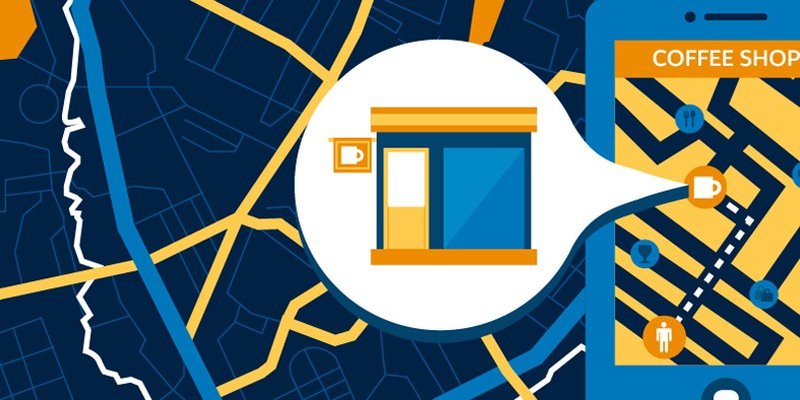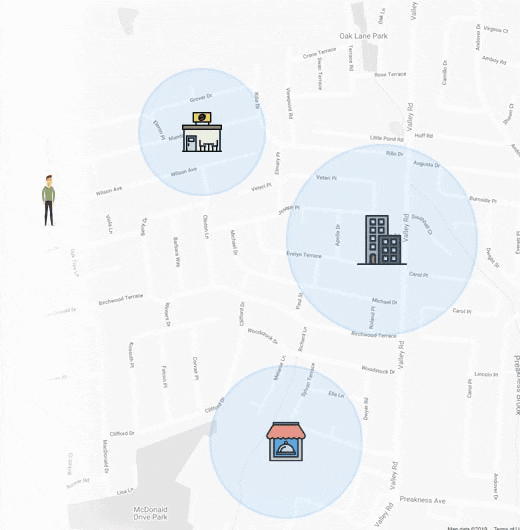Have you ever wondered how you got a notification when you passed by a store or a café and thought about buying a coffee?
Have you ever gotten a coupon for a phone case right after purchasing a smartphone?
If these examples sound familiar, it's because of geofencing marketing.

What exactly is geofencing?
Geofencing is a type of location-based marketing tool that, when combined with an app, creates a virtual geographical boundary that employs GPS technology to send notifications and alerts to a user.
What exactly is geofencing marketing?
Geofencing marketing is a type of location-based marketing in which a virtual boundary is created around a predefined location using GPS (Global Positioning System) via satellite.
A smartphone user can enter or exit a virtual boundary known as a geofence, location target, or geotargeting.
With so many options, it is best to narrow down the target audience in order to send out appropriate notifications and marketing campaigns.
Geofencing Marketing: Segmentation
According to Straits Research, the geofencing market can be categorized by component, type, technology, deployment, and vertical.
By Type
- Fixed Geofencing
- Mobile Geofencing
By Component
- Service
- Solution
By Technology
- GPS
- RFID
- Wi-Fi
- Cellular Network
By Deployment
- On-premise
- On cloud
By Vertical
- Retail
- Healthcare
- Government
- Events
- Law
- Transportation and Logistics
How does geofencing marketing work?
Geofencing marketing is a powerful marketing technique that allows businesses to engage with their customers based on their "hyper-local" location. A geofence can be set up with a geographical boundary of up to 1000 meters and as little as 200 meters.
To summarize, geofencing marketing works as follows:
- The company creates a geofence for a specific area as well as an ad campaign for that geofence.
- When a user enters the geofenced area, they are added to the advertising audience.
- The company then begins to push advertisements to the user via notifications, in-app ads, or coupons.
A geofencing marketing campaign may include a promotion, discount, invitation, or simply a greeting message.
By using geofencing marketing, a company can control when its advertisements appear. If there is significantly more traffic in the evenings, for example, the ads can be set to appear during that time period on apps and webpages to achieve the best results.
How to Implement Geofencing Marketing
Creating a geofencing marketing campaign is as simple as five steps.
- Make the geofence
- Create a landing page
- Examine the data
- Fine-tune
- Connect the SDK to the app
Elements to keep in mind before setting up geofencing marketing

1. Privacy
Before implementing geofencing, app users should be informed that their geographical data will be accessed and used to send out deals and promotions.
In the event that there are complaints about data usage by third-party apps, the intent and purpose of the data usage should be explicitly stated.
2. Problems with Batteries
Users' device batteries may die as a result of the continuous use of GPS in the background. As a result, it is critical to find a geofencing solution that is not reliant on GPS.
3. GPS Precision
A geofencing marketing campaign revolves around the location. Optimization of the location's accuracy must be processed without the interference of too many resources for a successful geofencing marketing campaign.
The ideal solution should be a balance of coarse and fine location from the customer's device.
In addition to location accuracy, it is critical to ensure that users have granted the app permission to store and use their location data in order to run the geofencing marketing campaign.
4. Collect three types of data.
When gathering information for a geofencing marketing campaign, ensure that the location data collected includes the user's prior visit history, dwell time, and foot traffic.
5. Actionable CTA
Before launching a geofencing marketing campaign, ensure that all engagement notifications triggered by the geofence have a clear, concise, and actionable call to action.
Tracking and analytics are critical to a successful campaign. To make well-informed decisions, make sure to analyze the collected data from the user's side as well as the location activity.
6. Keep a well-defined dashboard.
Use a solution that offers a distinct and well-defined dashboard system with all of the tools needed to create and manage geofencing marketing campaigns in one location.
7. Create an app
The most important aspect of the campaign is the creation of a geofencing marketing app. Geofencing marketing is ineffective without an app.
An app that works in tandem with geofencing can assist brands in engaging with their customers in real time and boosting conversations in order to increase sales.
How much does it cost to set up a geofencing marketing campaign?
The cost of launching a geofencing marketing campaign varies. Typically, the cost per thousand impressions (CPM) ranges between $5 and $15. (CPM = Cost Per Thousand Impressions). The price is influenced by a number of factors, including impression volume, features on the integrated app, and other targeting features.
How to Make Use of Geofencing Marketing
Setting up a geofencing marketing campaign may appear difficult, but it is actually quite simple and easy to troubleshoot.
A geofence can be placed anywhere, including around the location of a business and its competitors. Any geographical area can be surrounded by a virtual boundary.
Where should geofencing marketing be used?
Geofencing marketing strategies can be used almost anywhere. Here are a few examples of locations that can be targeted with geofencing marketing:
- The primary location of the company
- Location of the competitor's business
- Events in the neighborhood
- Stores and streets nearby
- Shopping malls
- Airports
- Addressable geofencing for households
- Nearby educational institutions and workplaces
Marketers use geofencing marketing in a variety of ways.
Marketers are one of the most common users of geofencing marketing. Geofencing campaigns have limitless potential.
Having said that, here are a few key practices that marketers commonly employ.
1.Brand engagement
The app's user engagement increases when users download the dedicated app and are prompted with a notification to encourage a purchase after entering the geofenced area.
2. SMS engagement
When users opt in to receive text messages from a brand on their smartphones, engagement automatically increases. When the user enters the geofenced area, SMS messages are sent.
3. Advertisement on social media
Brands send out advertisements to users in the context of social media when they enter a geofenced area, using Facebook and Instagram's local awareness.
4. Internet advertisements
Users enter a geofenced area, and ads from a specific brand are delivered to them via Google AdWords as they surf the web.
5. Engagement with third-party apps
If users install a third-party app, such as a restaurant finder, the brand's geofenced messages are delivered through that app.
Geofencing marketing is proving effective in a variety of industry verticals.
Here are some of the business verticals that are utilizing geofencing to improve their marketing strategies in order to maximize the power of geofencing:
3. Geofencing in real estate
Geofencing marketing is an excellent real estate marketing tool. Real estate agents can use geofencing to create a virtual boundary and receive notifications whenever a potential onlooker or buyer enters or exits the boundary.
Geofencing in real estate conversions while also assisting real estate agents in weeding out unwanted clients.
2. Geofencing in retail
A geofence can be set up within a retail store's perimeter. A location-based alert will be sent to the user every time they pass by the defined area. Offer a deal that will entice them to come in and shop at your store.
3. Geofencing in the legal field:
Geofencing marketing can be set up by a law firm, attorney, or lawyer to target specific areas of interest. To reach their target audience, they may choose to visit jails, hospitals, or courts. Geotargeting could also be implemented to generate more leads.
4. Geofencing for automobile dealerships
A car dealer could create a geofenced advertisement that would target a user who was leaving a competitor's store.
The automotive dealer can provide a better deal or discount to allow the user to browse the options at the geofenced location and address a specific pain point that the competitor did not address.
5. Event geofencing
Geofencing around tour destinations, events, and concerts can be set up ahead of time by artists and musicians to target their audience and notify fans.
They can also use intrigue to promote their upcoming shows to audiences who are unfamiliar with them or to their fans.
The information gathered could be used to analyze their users' behavior in order to better understand their mindset and to plan future events.
6. Geofencing in healthcare
The healthcare industry, regardless of profit margin, can greatly improve its marketing strategy by incorporating geofences into its overall marketing strategy.
Hospitals and private practice clinics can notify their users who enter the geofenced area in a timely and appropriate manner.
Geofencing Marketing Case Studies
1. Increase hyperlocal sales
Geofencing enables apps and marketers to precisely pinpoint and track the location of their users in order to deliver products and services more effectively.
Marketers can use this feature to filter their target audience and send out relevant messages and notifications to boost hyper-local sales.
2. Increase your sales by increasing traffic.
3. Retention of customers
Marketers can take advantage of the flexibility of geofencing to bring customers back to the outlet.
Geofencing allows marketers to track shoppers' past behavior and use that data to send appropriate notifications to the user in the form of a discount, loyalty program, exclusive member-only sales, and games to entice them to return to the outlet.
4. Initiate feedback when the geofence is exited.
Marketers can contact users who have left the geofenced location and ask them to fill out a feedback form so that they can learn more about their experience.
This can be accomplished through a variety of means, including surveys, games, or even by enticing people to fill out a form in exchange for a coupon.
5. Social media networking
Geofencing marketing is used by all social media platforms, including Instagram, Facebook, Twitter, and Snapchat, to serve highly customized content, advertisements, and location-based filters that are highly specific to that location.
6. Improving the user experience
Geofencing is a dynamic system. This implies that marketers can use geofencing to track and gauge their audiences' behavior around the geofenced area and the app.
The collected data can then be used to provide highly personalized offers and services in order to better serve customers and, as a result, increase the overall ROI of the outlet.
7. Boost engagement and conversion rates.
The desire of every customer is to receive the right offer at the right time. This need will be amplified by geofencing marketing.
Implementing geofencing marketing will increase the sales conversion ratio marginally and generate more revenue. In the long run, this aids in increasing brand engagement and increasing unwavering customer loyalty.
8. Data analytics and optimization
Geofencing marketing relies heavily on location and data analytics. The geofencing marketing strategy is heavily reliant on these two factors.
It is based on data, which alerts marketers to take appropriate action by sending out the necessary information. Geofencing also provides real-time data.
Some elements that can be measured are as follows:
- Views and impressions of advertisements
- Visit conversion zones
Geofencing marketing has the added benefit of allowing campaigns to be edited in real-time based on the data collected.
If users do not respond to promotions, marketers can investigate why and re-edit the promotion in real time to attract more customers.
9. Increase the accuracy of customer behavioral data.
Users who enter and exit the geofenced area can provide marketers with valuable insights that can be used for a variety of purposes.
Marketers can research a user's purchasing habits and the types of products they are interested in. This can be used to enhance and improve the profile of each customer in order to provide better service.
Why should a brand's marketing strategy include geofencing?
Data-driven information drives the best decisions when it comes to adopting any new technology. Here are some statistics to back up my point:
- 40% of shoppers look for information while they are on the go.
- 70% of users are willing to share their location with a brand in exchange for a benefit.
- Increase secondary action rates—with location-based marketing, users visit a store twice after seeing an advertisement.
- On their smartphones, 60% of consumers look for local information.
- Secondary action rates are highest in trade and home services.
In addition, there are four major advantages to incorporating geofencing into a brand's marketing mix—
1. Targeting
With geofencing, brands gain the ability to choose when to send messages that are far more relevant and timely.
A brand is much more likely to attract consumers if it targets users who are constantly on the move and geographically close by, in addition to adding other targeting criteria on top, such as analytics.
2. Concise data
Geofencing allows marketers to collect data that is often overlooked. A brand can gather valuable information on traffic patterns, dwell time, and messaging effectiveness with the right kind of platform.
3. Effectiveness
A brand can reach out to audiences who are more likely to take action using geofencing marketing. Geofencing assists marketers in filtering out irrelevant target audiences, implying that brands will spend less on an irrelevant audience.
Improved engagement lead generation always results in more effective marketing spend.
4. Attribution
Marketers have long wanted a link between advertising and action. Geofencing technology allows marketers to gauge how customers react when they come across an actionable advertisement. Better data collection, better targeting, and attribution leads to more effective spending, says Nadeau.
Geofencing Marketing: Consumer Marketing Evolution
By 2022, the geofencing market is expected to be worth $1.8 billion. Travel and logistics are the industries that are expected to grow the most. Because of its high mobile phone penetration, North America is expected to lead the geofenced marketing market. During the forecast period, Asia is expected to be the fastest-growing region.
Geofencing marketing opens up a world of possibilities for both consumers and marketers. Geofencing can be used by consumers as a reminder tool, home security systems, automatic coffee makers, and to receive offers from their favorite restaurants. Marketers can also use geofencing technology to send out regular push notifications and mobile advertisements.
Source: Beaconstac






